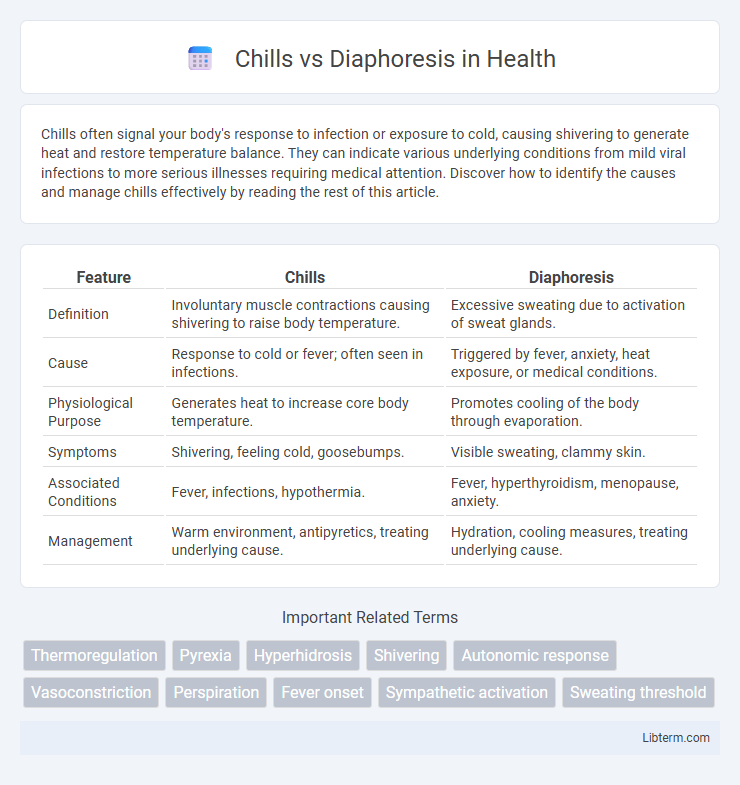Chills often signal your body's response to infection or exposure to cold, causing shivering to generate heat and restore temperature balance. They can indicate various underlying conditions from mild viral infections to more serious illnesses requiring medical attention. Discover how to identify the causes and manage chills effectively by reading the rest of this article.
Table of Comparison
| Feature | Chills | Diaphoresis |
|---|---|---|
| Definition | Involuntary muscle contractions causing shivering to raise body temperature. | Excessive sweating due to activation of sweat glands. |
| Cause | Response to cold or fever; often seen in infections. | Triggered by fever, anxiety, heat exposure, or medical conditions. |
| Physiological Purpose | Generates heat to increase core body temperature. | Promotes cooling of the body through evaporation. |
| Symptoms | Shivering, feeling cold, goosebumps. | Visible sweating, clammy skin. |
| Associated Conditions | Fever, infections, hypothermia. | Fever, hyperthyroidism, menopause, anxiety. |
| Management | Warm environment, antipyretics, treating underlying cause. | Hydration, cooling measures, treating underlying cause. |
Understanding Chills: Definition and Causes
Chills refer to involuntary muscle contractions that cause shivering and a sensation of cold, often preceding fever or infection. Common causes include viral or bacterial infections, exposure to cold environments, and systemic illnesses like influenza or sepsis. Understanding chills involves recognizing their role as the body's response to raising core temperature to combat pathogens.
What Is Diaphoresis? Key Features Explained
Diaphoresis refers to excessive sweating often triggered by fever, stress, or underlying medical conditions such as hyperthyroidism or infections. Key features include profuse sweating unrelated to environmental temperature or physical exertion and it can signal symptoms like heart attack or severe infections. Unlike chills, which cause shivering and cold sensations due to body temperature fluctuations, diaphoresis involves active sweating as a physiological response to regulate body heat or stress.
Core Differences Between Chills and Diaphoresis
Chills refer to the sensation of cold accompanied by shivering, often triggered by fever or infection, signaling the body's attempt to raise core temperature. Diaphoresis, in contrast, is characterized by excessive sweating due to autonomic nervous system activation, often linked to stress, fever, or cardiovascular issues. The core difference lies in chills causing cold-induced muscle contractions and temperature increase, while diaphoresis involves active sweat gland secretion to cool the body down.
Common Medical Conditions Associated with Chills
Chills often occur in medical conditions such as influenza, malaria, sepsis, and pneumonia, where the body attempts to generate heat in response to infection or inflammation. Diaphoresis, characterized by excessive sweating, frequently accompanies conditions like hyperthyroidism, hypoglycemia, and autonomic dysfunction, but chills are specifically indicative of systemic infections or febrile illnesses. Recognizing chills alongside fever is critical for diagnosing bacterial or viral infections requiring immediate medical intervention.
Health Issues Linked to Diaphoresis
Diaphoresis, or excessive sweating, often signals underlying health problems such as infections, cardiovascular conditions, or endocrine disorders like hyperthyroidism. Unlike chills, which indicate a body temperature regulation issue usually associated with fever or cold exposure, diaphoresis can also be a symptom of anxiety or adverse drug reactions. Recognizing diaphoresis as a clinical sign is crucial for diagnosing serious conditions like myocardial infarction or hypoglycemia.
Symptoms: How Chills and Diaphoresis Present
Chills manifest as an intense feeling of cold accompanied by shivering, often preceding a fever or infection and indicating the body's attempt to raise its core temperature. Diaphoresis presents as excessive sweating unrelated to environmental heat, frequently signaling underlying conditions such as infections, hypoglycemia, or autonomic dysfunction. Differentiating symptoms includes chills causing repeated muscle contractions, while diaphoresis involves profuse, unprovoked sweating regardless of temperature.
Diagnostic Approach: Identifying Chills vs Diaphoresis
The diagnostic approach to distinguishing chills from diaphoresis involves careful evaluation of patient history, physical examination, and context of symptom onset. Chills typically present as involuntary muscle contractions causing a sensation of cold despite normal or elevated body temperature, often linked to febrile illnesses or infections. In contrast, diaphoresis is characterized by excessive sweating unrelated to temperature changes, commonly associated with autonomic dysfunction, hypoglycemia, or cardiac events, requiring targeted laboratory tests and monitoring for accurate diagnosis.
Treatment Options for Chills and Diaphoresis
Treatment options for chills primarily involve addressing the underlying cause, such as infections where antipyretics like acetaminophen or ibuprofen reduce fever and alleviate chills. For diaphoresis, management includes treating the root condition, such as infections, hyperthyroidism, or anxiety, with targeted medications and supportive therapies like hydration and antiperspirants if necessary. Both symptoms may require supportive care, including maintaining a comfortable environment and monitoring for complications.
When to Seek Medical Attention
Chills accompanied by high fever, persistent shaking, or confusion require immediate medical evaluation to rule out infections such as sepsis or severe influenza. Diaphoresis that occurs with chest pain, shortness of breath, or sudden weakness may indicate a heart attack or other serious cardiovascular conditions needing urgent care. Seek prompt medical attention if either symptom is sudden, severe, or associated with other alarming signs like altered consciousness or severe headache.
Preventive Tips for Managing Chills and Diaphoresis
Maintaining a stable environment by dressing in layers and regulating room temperature can help prevent chills by minimizing sudden heat loss. To manage diaphoresis, staying hydrated and avoiding triggers such as spicy foods, caffeine, and stress reduces excessive sweating episodes. Regular monitoring of underlying conditions like infections or hormonal imbalances enables timely intervention to control both chills and diaphoresis effectively.
Chills Infographic

 libterm.com
libterm.com